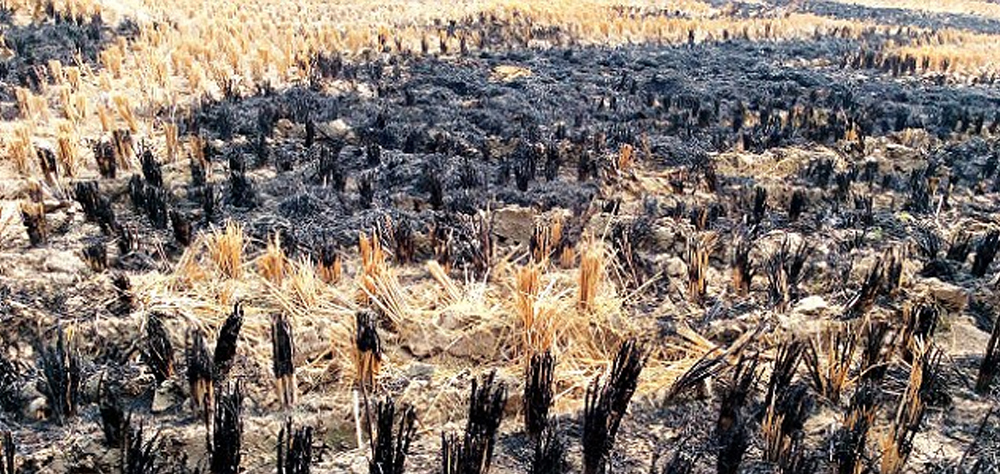
Holistic stakeholder participation to solve Delhi’s (burning) issue
For an agribusiness consultant, it is hard not to analyze the recurring air pollution woes in our capital city. The issue is even more perplexing due to its most widely acknowledged contributor – crop stubble burning.This practice has been primarily confined to Punjab, Haryana, and parts of Uttar Pradesh, where farmers grow wheat and paddy crops. In the Punjab-Haryana-UP belt, wheat is grown for 140-150 day period, starting around November 15 and maturing towards mid-April. However, since paddy is sown only after mid-May, and transplanted only after mid-June, the crop is not ready for harvesting before mid-October. This leaves a very narrow period between harvesting of paddy crop and sowing of wheat crop. Farmers are left with limited cost and time saving options to clear the field of leftover paddy straw, resulting in stubble burning, which takes place between mid-October and second week of November. This condition is exacerbated by Delhi’s geographical situation. The city is plagued by a meteorological phenomenon called inversion, experienced during winter months in northern India. Simplistically put, warm air being lighter rests above colder dense air (which is closer to the ground), and behaves like a lid by preventing it from mixing upwards, essentially trapping all the pollution throughout winter, leaving the city in a haze.
But before jumping into a blame game, we need to ask: What have governments done to mitigate the root cause of burning crop stubble? Are simple corrective actions against farmers justified? Is it fair to blame particular stakeholders, when the problem is multifactorial in nature?Local emission sources from vehicular emissions, industrial pollution, and construction dust, are constant factors contributing to Delhi’s pollution. While crop stubble burning is certainly a contributing factor, its occurrence is episodic and depends on wind direction and other meteorological factors. In recent years, however, Capital’s pollution woes have been aggravated by the city’s faltering infrastructural and public transport system, increasing HMV traffic and private vehicular density.
With the blanket ban on stubble burning by the National Green Tribunal (NGT), governments have resorted to punitive measures such as fines,  raids by police and pollution control officials, which are likely counter-productive measures harassing farmers already reeling under the burden of high input costs and labour shortages. Alternatives to crop burning, as such are not lucrative to farmers, since paddy straw fetches low rates, and are less attractive options for their animals compared to superior fodder such as wheat straws or millets.Farmers findcutting out stubble or ploughing it back into the soil as uneconomical options. Manually, this exercise is labour-intensive (labour costs are high due to shortage) and mechanized options are expensive. Additionally, it is challenging to alter traditional farm practices and cropping patterns overnight.
raids by police and pollution control officials, which are likely counter-productive measures harassing farmers already reeling under the burden of high input costs and labour shortages. Alternatives to crop burning, as such are not lucrative to farmers, since paddy straw fetches low rates, and are less attractive options for their animals compared to superior fodder such as wheat straws or millets.Farmers findcutting out stubble or ploughing it back into the soil as uneconomical options. Manually, this exercise is labour-intensive (labour costs are high due to shortage) and mechanized options are expensive. Additionally, it is challenging to alter traditional farm practices and cropping patterns overnight.
Possible solutions
While there is a need to sensitize farmers about managing crop residue, it should also be the government’s mandate to provide incentives to facilitate them in this process.  Technological interventions by way of Combine Harvesters, Happy Seeders, or Straw Management Systems can alleviate these situations, however, all farm mechanization efforts require financialsupport. Several policies exist to promote crop diversification (to break away from rice-wheat rotation), promotion of ‘zero tillage’, and agricultural waste management by use of rice residue as fodder or bedding material for cattle, or use in biomass or biogas production. However, farmer groups contend that these policies are only on paper, with limited practical feasibility in the absence of state support.
Technological interventions by way of Combine Harvesters, Happy Seeders, or Straw Management Systems can alleviate these situations, however, all farm mechanization efforts require financialsupport. Several policies exist to promote crop diversification (to break away from rice-wheat rotation), promotion of ‘zero tillage’, and agricultural waste management by use of rice residue as fodder or bedding material for cattle, or use in biomass or biogas production. However, farmer groups contend that these policies are only on paper, with limited practical feasibility in the absence of state support.
It is also time for enterprising firms and start-ups to step forward with viable business and technological solutions to these problems. Opportunities in terms of innovative financial-lending options, agri-machinery co-ownership models, involvement in biomass and biofuelproduct supply chain, frugal (low-cost) mechanical devices for stubble removal, or industrial applications of crop residue, should be leveraged.Complex problems often require holistic stakeholder participation – including the government, public and private sector, civil society organizations, farmer communities, and consumer groups – to mitigate the capital’s pollution woes. So is it fair to ask if farmers are the cause of Delhi’s (burning) issue?
Author

 Grow Beyond
Grow Beyond 

